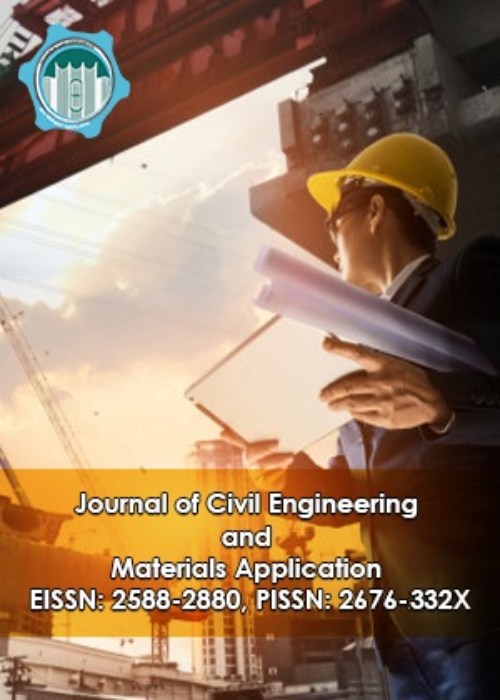فهرست مطالب

Journal of Civil Engineering and Materials Application
Volume:4 Issue: 3, Summer 2020
- تاریخ انتشار: 1399/07/21
- تعداد عناوین: 5
-
Pages 133-140
Eocene Green Tuffs are widespread in Central Alborz in the north of Iran. In parts, they are used as natural Pozzolan. In this study, the Pozzolanic activities of tuff samples from Qazvin to Semnan in Alborz Mountain were examined. The Pozzolanic activity patterns vary in different beds and even change laterally. Chemical examination of the samples indicated that they all belong to acidic rock group and were consistent with related standards. Pozolanic activity calculated for samples using hydraulic factor, thermal analysis and ion concentrations. Data obtained based on thermal analysis, presented a range of Pozzolanic activities for tuffs with similar chemistry and appearance. It was found in this research that mineralogy and texture controlled Pozzolan activity. Tuffs with high activity had glass in their matrix, but weathering and recrystallization reduced the activity. Petrographical examinations play an essential role in evaluating the availability of tuffs as natural Pozzolan in Central Alborz.
Keywords: Natural Pozzolan, Petrography, Pozzolanic Activity, Alborz Mountains, Iran -
Pages 141-153Energy dissipation devices are widely used to enhance the response of structures subjected to dynamic loads caused by wind and earthquake. Especially, viscous dampers are hydraulic devices widely used in structural engineering that dissipate mechanical energy by producing a damping force against the motion. The dampers can mitigate transversal and longitudinal or vertical displacement. It can be set up in different kinds of structures. This study is aimed at comparing the impact of various Fluid viscous damper parameters on the structures under the earthquake. To this aim, a seven-story steel frame structure retrofitted with fluid viscous dampers was considered for analyzing with a variety of parameters. The results showed that installing longitudinal nonlinear Fluid viscous damper can reduce the seismic response significantly, by selecting affordable damping parameters including stiffness, damping coefficient, and velocity exponent. The optimum damping parameters can be calculated accurately by analyzing structure with different damping parameters of nonlinear Fluid viscous damper.Keywords: Damper parameters, damping force, damping coefficient, Velocity exponent, Seismic Performance
-
Pages 155-160This paper presents the results of the FTIR (Fourier-Transform Infrared) spectroscopy study of commercially available silicone-based sealant materials commonly used for sealing voids, cracks, and joints in non-structural building components of commercial and residential buildings. The sealants prevent moisture leakage through the parts, making the building envelope air and water-tight, sustainable, and energy-efficient. FTIR spectroscopy is a widely used technique in characterizing pharmaceutical products, mineralogical compositions, forensic analysis, food, chemical, semiconductor, petroleum, and agro-industries. This work demonstrates the application of FTIR analysis in the study of construction materials. It reports the IR (Infrared) spectral signatures of the selected building joint sealants used in the construction industry. It is found that several IR bands are common to most of the samples, suggesting that there is a reasonable similarity in the molecular composition of the three different manufacturer brands, including DAP (Dicks-Armstrong-Pontius), GE (General Electric), and HDX (Home Depot Product). Despite the multiple similarities in the IR bands of the samples studied, the FTIR techniques provided enough evidence to distinguish the samples and suggest that the composition and molecular structures of most of the silicone brands possess unique IR signatures.Keywords: FTIR analysis of building materials, Joint sealant, Characterization of construction materials, FTIR bands of building sealants, Characterization of silicone sealants
-
Pages 161-177
The main objective of this paper is determining comfortableness of a composite structural floor system known as Chromite. For this purpose, twenty-eight Chromite panels were developed via Finite Element Method (FEM) to find their Fundamental Natural Frequency (FNF). Then, the studied panels categorized as Low Frequency Floor (LFF) or High Frequency Floor (HFF) regarding to their FNFs. Peak accelerations of low and high frequency panels and also static stiffness of high frequency panels were determined and compared with the limit value affirmed by American Institute of Steel and Construction (AISC). Effect of various parameters were determined on changing FNF and also peak acceleration and static stiffness of the studied panels, depend to kind of panel as LFF or HFF. The results demonstrated that although some factors decreased and increased peak acceleration and static stiffness of the Chromite system, respectively, the panels could reach high vibration levels resulting in lack of comfortableness for users. In addition, the results show that the Chromite floor system needs to improve to be comfort for users.
Keywords: Chromite floor system, comfortableness, human walking load, static, dynamic response, low, high frequency floor -
Pages 179-193
Settlements in the ground and deep soil layers can occur after the liquefaction phenomenon. These deformations damage structures, buildings, and lifelines. Based on fields and laboratory data, several practical methods have recently been proposed for evaluating volumetric strain (settlement) and maximum shear strain due to liquefaction. The present study mainly aimed to compare liquefaction potential assessment findings in terms of risk intensity and settlement values of soil layers after liquefaction using Standard Penetration Test (SPT) and Energy Methods along Tabriz Metro Line 1. Thus, 31 boreholes along the path were selected in this regard. Then, the liquefaction potential of soil layers was assessed based on the above-mentioned methods and liquefaction potential risk index was determined as well. Finally,, the settlement value of soil layers was evaluated according to the findings of the two proposed methods. The findings showed that both processes were relatively correlated and the energy method proposed higher liquefaction potential risk compared to the SPT procedure.
Keywords: Energy, Liquefaction, Settlement, Standard penetration test, Tabriz Metro Line 1


